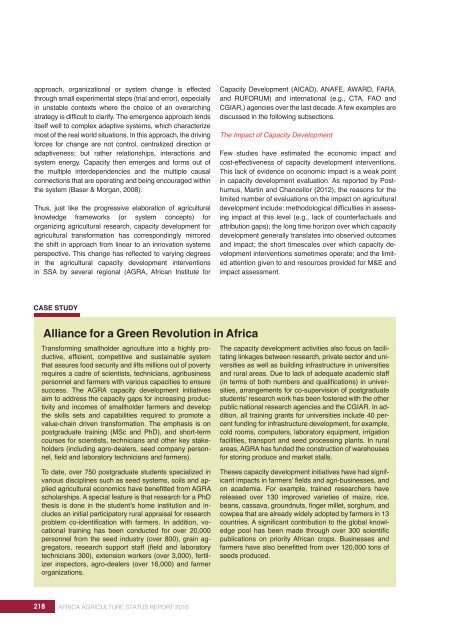AFRICA AGRICULTURE STATUS REPORT 2016
AASR-report_2016-1
AASR-report_2016-1
Create successful ePaper yourself
Turn your PDF publications into a flip-book with our unique Google optimized e-Paper software.
approach, organizational or system change is effected<br />
through small experimental steps (trial and error), especially<br />
in unstable contexts where the choice of an overarching<br />
strategy is difficult to clarify. The emergence approach lends<br />
itself well to complex adaptive systems, which characterize<br />
most of the real world situations. In this approach, the driving<br />
forces for change are not control, centralized direction or<br />
adaptiveness; but rather relationships, interactions and<br />
system energy. Capacity then emerges and forms out of<br />
the multiple interdependencies and the multiple causal<br />
connections that are operating and being encouraged within<br />
the system (Baser & Morgan, 2008).<br />
Thus, just like the progressive elaboration of agricultural<br />
knowledge frameworks (or system concepts) for<br />
organizing agricultural research, capacity development for<br />
agricultural transformation has correspondingly mirrored<br />
the shift in approach from linear to an innovation systems<br />
perspective. This change has reflected to varying degrees<br />
in the agricultural capacity development interventions<br />
in SSA by several regional (AGRA, African Institute for<br />
Capacity Development (AICAD), ANAFE, AWARD, FARA,<br />
and RUFORUM) and international (e.g., CTA, FAO and<br />
CGIAR,) agencies over the last decade. A few examples are<br />
discussed in the following subsections.<br />
The Impact of Capacity Development<br />
Few studies have estimated the economic impact and<br />
cost-effectiveness of capacity development interventions.<br />
This lack of evidence on economic impact is a weak point<br />
in capacity development evaluation. As reported by Posthumus,<br />
Martin and Chancellor (2012), the reasons for the<br />
limited number of evaluations on the impact on agricultural<br />
development include: methodological difficulties in assessing<br />
impact at this level (e.g., lack of counterfactuals and<br />
attribution gaps); the long time horizon over which capacity<br />
development generally translates into observed outcomes<br />
and impact; the short timescales over which capacity development<br />
interventions sometimes operate; and the limited<br />
attention given to and resources provided for M&E and<br />
impact assessment.<br />
CASE STUDY<br />
Alliance for a Green Revolution in Africa<br />
Transforming smallholder agriculture into a highly productive,<br />
efficient, competitive and sustainable system<br />
that assures food security and lifts millions out of poverty<br />
requires a cadre of scientists, technicians, agribusiness<br />
personnel and farmers with various capacities to ensure<br />
success. The AGRA capacity development initiatives<br />
aim to address the capacity gaps for increasing productivity<br />
and incomes of smallholder farmers and develop<br />
the skills sets and capabilities required to promote a<br />
value-chain driven transformation. The emphasis is on<br />
postgraduate training (MSc and PhD), and short-term<br />
courses for scientists, technicians and other key stakeholders<br />
(including agro-dealers, seed company personnel,<br />
field and laboratory technicians and farmers).<br />
The capacity development activities also focus on facilitating<br />
linkages between research, private sector and universities<br />
as well as building infrastructure in universities<br />
and rural areas. Due to lack of adequate academic staff<br />
(in terms of both numbers and qualifications) in universities,<br />
arrangements for co-supervision of postgraduate<br />
students’ research work has been fostered with the other<br />
public national research agencies and the CGIAR. In addition,<br />
all training grants for universities include 40 percent<br />
funding for infrastructure development, for example,<br />
cold rooms, computers, laboratory equipment, irrigation<br />
facilities, transport and seed processing plants. In rural<br />
areas, AGRA has funded the construction of warehouses<br />
for storing produce and market stalls.<br />
To date, over 750 postgraduate students specialized in<br />
various disciplines such as seed systems, soils and applied<br />
agricultural economics have benefitted from AGRA<br />
scholarships. A special feature is that research for a PhD<br />
thesis is done in the student’s home institution and includes<br />
an initial participatory rural appraisal for research<br />
problem co-identification with farmers. In addition, vocational<br />
training has been conducted for over 20,000<br />
personnel from the seed industry (over 800), grain aggregators,<br />
research support staff (field and laboratory<br />
technicians 300), extension workers (over 3,000), fertilizer<br />
inspectors, agro-dealers (over 16,000) and farmer<br />
organizations.<br />
Theses capacity development initiatives have had significant<br />
impacts in farmers’ fields and agri-businesses, and<br />
on academia. For example, trained researchers have<br />
released over 130 improved varieties of maize, rice,<br />
beans, cassava, groundnuts, finger millet, sorghum, and<br />
cowpea that are already widely adopted by farmers in 13<br />
countries. A significant contribution to the global knowledge<br />
pool has been made through over 300 scientific<br />
publications on priority African crops. Businesses and<br />
farmers have also benefitted from over 120,000 tons of<br />
seeds produced.<br />
218 <strong>AFRICA</strong> <strong>AGRICULTURE</strong> <strong>STATUS</strong> <strong>REPORT</strong> <strong>2016</strong>


